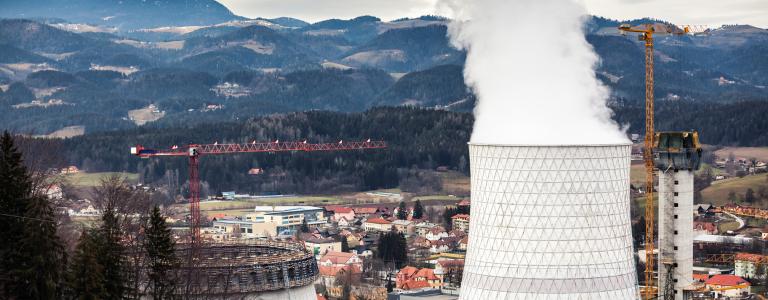Newly Released Text for Modernized Energy Charter Treaty Shows Too Many Potential Obstacles for Climate Action
The text of the agreement in principle to modernize the Energy Charter Treaty (ECT), made public on Monday September 12 by POLITICO Pro, leaves unanswered too many crucial questions about the possibility of further fossil fuel carveouts and the exact timing of its entry into force—key factors that will determine its climate impact. The result is a treaty that creates significant legal uncertainty for governments as they seek to put in place climate action measures in line with the Paris Agreement’s objectives, IISD analysis finds.
This uncertainty adds to those shortfalls of the ECT that the modernization failed to address from the outset—particularly the treaty’s much-criticized investor–state dispute settlement provision and its 20-year sunset clause.
The original ECT emerged in the mid-1990s amid the aftermath of the Cold War, with the goal of fostering multilateral cooperation on energy issues. In the years since, the treaty has expanded to include over 50 contracting parties spanning across most of Europe and parts of the Middle East and Asia.
The ECT has also gained notoriety for the many legal cases filed by fossil fuel investors under the treaty in response to climate-related laws and regulations. Some of these cases have led to exorbitant awards against governments. IISD research has found that 17% of all investor–state disputes from fossil fuel investors have been brought under the ECT—more than under any other international investment agreement.
Negotiations to modernize the ECT began in 2020, with contracting parties announcing in June 2022 that they had reached an agreement in principle. At that time, only a public communication was circulated summarizing some of the suggested reforms, which already showed that the modernized treaty would still leave in place broad investor protection standards and, even where these have new exceptions or carve-outs, there would be major loopholes in place that could render these exceptions and carve-outs largely ineffective.
At the time, IISD analysis also found that the modernized ECT would still leave new and existing fossil fuel investments in at least 20 contracting parties protected indefinitely—for the European Union (EU) and the United Kingdom (UK), existing investments would still enjoy at least 10 years of protection. The text published by Politico confirms these concerns and fuels further questions over how the modernized treaty would work in practice.
“The text released today confirms what we had already feared: that while there have been some useful innovations, such as carveouts by the EU and the UK of some fossil fuel investments from investment protection, the deletion of the non-derogation clause, and the exclusion of intra-EU arbitration, overall the agreement still leaves many core issues open to interpretation or debate,” said Lukas Schaugg, International Law Advisor at IISD. “For instance, we still don’t know exactly when the fossil fuel carveouts would enter into force and whether entry into force would be simultaneous in most ECT Contracting Parties. And that means legal uncertainty for governments and investors alike, which neither can afford.”
Recent legal cases have only served to underscore the problems inherent in the current ECT’s design, such as the multi-million-pound award to the UK oil firm Rockhopper in a case filed against the Italian government for having put in place a ban against offshore drilling in its territorial waters.
“We are staring down a climate crisis that requires decisive, ambitious, and targeted action, not piecemeal reforms of problematic treaties. The ECT was never designed for our climate challenge, and trying to retrofit it now around that goal just won’t be enough,” said Nathalie Bernasconi-Osterwalder, Executive Director of IISD Europe and Senior Director of IISD’s Economic Law and Policy Program.
“If we want to stand any chance of tackling the climate crisis, we need governments to come together and create a new investment treaty that is designed around advancing climate-friendly investments from the outset—and that actively disincentivizes those investments that get in the way of that goal,” said Bernasconi-Osterwalder.
IISD will publish a detailed legal analysis of the ECT agreement in principle over the coming days.
You might also be interested in
New Agreement Marks First Step in Addressing Energy Charter Treaty Legacy
This is an important move to prevent legacy arbitration claims under the treaty, but more remains to be done.
IISD: EU’s historic Energy Charter Treaty vote will boost energy transition
The European Parliament has voted for the European Union to withdraw from the climate-threatening Energy Charter Treaty.
Bruxelles propose une sortie à l’échelle de l’UE du traité sur la Charte de l’énergie, considéré comme contraire au Green Deal
La Commission européenne a formellement proposé un retrait « coordonné et ordonné » du traité sur la Charte de l’énergie. La législation proposée, dévoilée vendredi après-midi après des jours de spéculation, verrait l’Union européenne et ses États membres quitter le traité controversé en même temps, évitant le chaos d’avoir des pays individuels suivant leur propre chemin. L’Allemagne, la France, l’Espagne, les Pays-Bas et la Pologne faisaient partie de ceux qui avaient précédemment annoncé leur intention de se retirer de manière unilatérale, à l’instar de l’Italie, qui a quitté la convention en 2016.
Brussels tables EU-wide exit from the Energy Charter Treaty, considered at odds with the Green Deal
The European Commission has formally proposed a "coordinated and orderly" withdrawal from the Energy Charter Treaty. The proposed legislation, unveiled on Friday afternoon after days of speculation, would see the European Union and its member states leave the controversial treaty at the same time, avoiding the chaos of having individual countries going their own way.
